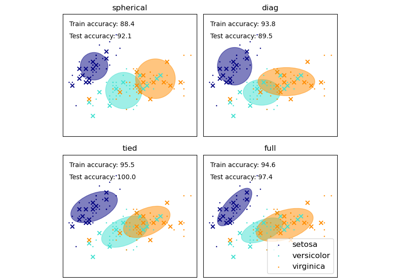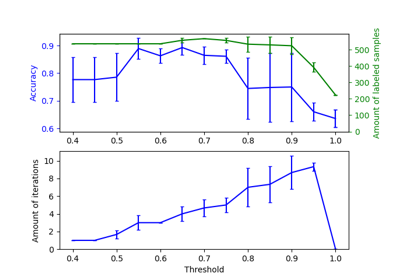StratifiedKFold#
- class sklearn.model_selection.StratifiedKFold(n_splits=5, *, shuffle=False, random_state=None)[source]#
Class-wise stratified K-Fold cross-validator.
Provides train/test indices to split data in train/test sets.
This cross-validation object is a variation of KFold that returns stratified folds. The folds are made by preserving the percentage of samples for each class in
yin a binary or multiclass classification setting.Read more in the User Guide.
For visualisation of cross-validation behaviour and comparison between common scikit-learn split methods refer to Visualizing cross-validation behavior in scikit-learn
Note
Stratification on the class label solves an engineering problem rather than a statistical one. See Cross-validation iterators with stratification based on class labels for more details.
- Parameters:
- n_splitsint, default=5
Number of folds. Must be at least 2.
Changed in version 0.22:
n_splitsdefault value changed from 3 to 5.- shufflebool, default=False
Whether to shuffle each class’s samples before splitting into batches. Note that the samples within each split will not be shuffled.
- random_stateint, RandomState instance or None, default=None
When
shuffleis True,random_stateaffects the ordering of the indices, which controls the randomness of each fold for each class. Otherwise, leaverandom_stateasNone. Pass an int for reproducible output across multiple function calls. See Glossary.
See also
RepeatedStratifiedKFoldRepeats Stratified K-Fold n times.
Notes
The implementation is designed to:
Generate test sets such that all contain the same distribution of classes, or as close as possible.
Be invariant to class label: relabelling
y = ["Happy", "Sad"]toy = [1, 0]should not change the indices generated.Preserve order dependencies in the dataset ordering, when
shuffle=False: all samples from class k in some test set were contiguous in y, or separated in y by samples from classes other than k.Generate test sets where the smallest and largest differ by at most one sample.
Changed in version 0.22: The previous implementation did not follow the last constraint.
Examples
>>> import numpy as np >>> from sklearn.model_selection import StratifiedKFold >>> X = np.array([[1, 2], [3, 4], [1, 2], [3, 4]]) >>> y = np.array([0, 0, 1, 1]) >>> skf = StratifiedKFold(n_splits=2) >>> skf.get_n_splits() 2 >>> print(skf) StratifiedKFold(n_splits=2, random_state=None, shuffle=False) >>> for i, (train_index, test_index) in enumerate(skf.split(X, y)): ... print(f"Fold {i}:") ... print(f" Train: index={train_index}") ... print(f" Test: index={test_index}") Fold 0: Train: index=[1 3] Test: index=[0 2] Fold 1: Train: index=[0 2] Test: index=[1 3]
- get_metadata_routing()[source]#
Get metadata routing of this object.
Please check User Guide on how the routing mechanism works.
- Returns:
- routingMetadataRequest
A
MetadataRequestencapsulating routing information.
- get_n_splits(X=None, y=None, groups=None)[source]#
Returns the number of splitting iterations as set with the
n_splitsparam when instantiating the cross-validator.- Parameters:
- Xarray-like of shape (n_samples, n_features), default=None
Always ignored, exists for API compatibility.
- yarray-like of shape (n_samples,), default=None
Always ignored, exists for API compatibility.
- groupsarray-like of shape (n_samples,), default=None
Always ignored, exists for API compatibility.
- Returns:
- n_splitsint
Returns the number of splitting iterations in the cross-validator.
- split(X, y, groups=None)[source]#
Generate indices to split data into training and test set.
- Parameters:
- Xarray-like of shape (n_samples, n_features)
Training data, where
n_samplesis the number of samples andn_featuresis the number of features.Note that providing
yis sufficient to generate the splits and hencenp.zeros(n_samples)may be used as a placeholder forXinstead of actual training data.- yarray-like of shape (n_samples,)
The target variable for supervised learning problems. Stratification is done based on the y labels.
- groupsarray-like of shape (n_samples,), default=None
Always ignored, exists for API compatibility.
- Yields:
- trainndarray
The training set indices for that split.
- testndarray
The testing set indices for that split.
Notes
Randomized CV splitters may return different results for each call of split. You can make the results identical by setting
random_stateto an integer.
Gallery examples#
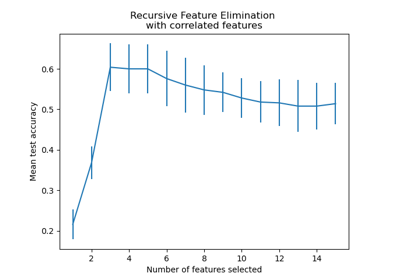
Recursive feature elimination with cross-validation
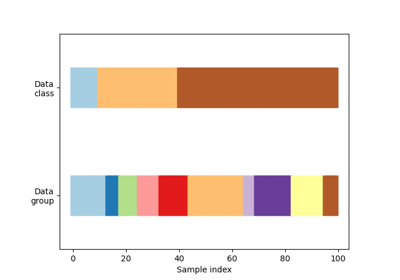
Visualizing cross-validation behavior in scikit-learn
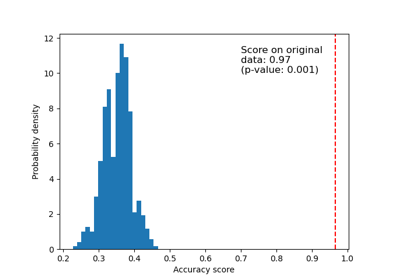
Test with permutations the significance of a classification score
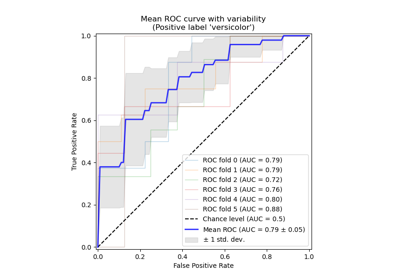
Receiver Operating Characteristic (ROC) with cross validation
